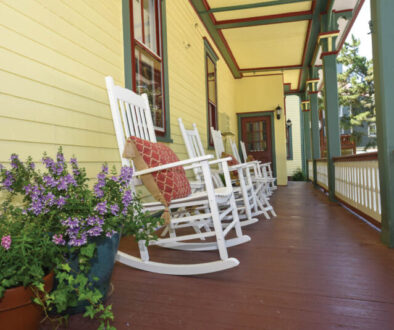Light it Up
There are so many things that go into design that it can be intimidating for the faint of heart. From creating a space that flows to selecting the wall plates, design—especially for a new build—is fraught with decisions. And while many of us naturally gravitate towards the fun stuff—the colors! The couches! The built-in bookcases! Oh my! —the truly design savvy know a room is nothing without lighting.
“I think of design as dressing the house,” says Christine Martenz, the in-house designer, and selections coordinator at DL Miner. “So, if you’re thinking about an outfit, you think in layers. If you’re going out, you’re going to think about the pants matching, then the shirt, then putting an accessory on there. The lighting is like your big accessory in the house. It stands alone. It doesn’t have to match anything specifically, and a lot of times, it’s the talking point and the thing that sets you apart as uniquely you. When we’re doing a project, the lighting is a really big feature. It’s probably the part of the project where we spend the most time.”
In fact, the lighting is done early in the project. In outfit terms, it’s more like planning an outfit around a pair of earrings than absently adding a pair of earrings afterwards. And it’s particularly important because like other hard features in a home, installed lighting fixtures—high hats, chandeliers, sconces and more—don’t change frequently; they should be things you can live with for a long time.

“I may not have the physical pieces of furniture picked out yet, but I generally have a furniture floor plan before I do the lighting,” says Martenz. “We want the spaces to talk together, to coordinate.”
Lighting is important, as anyone who’s ever had to find his or her keys in the dark or maneuver through a house affected by a power outage can attest. But it’s more than an important practicality: lighting affects both behavior and mood as much as it provides a function.
“In the kitchen and bathroom especially, you want to have light that provides task lighting or a light that really illuminates what you need it to. In your kitchen, you need adequate lighting to make sure you can safely cook,” says Martenz. “But also, there’s a behavioral aspect. There’s nothing fun about working in a shadow.”
There are different types of lighting for different types of needs. Task lighting is literally that—lighting that helps with tasks, taking on a functional role. It’s often the kind of lighting you don’t notice unless you don’t have it. Think recessed high hats, or under-counter lighting.
“There’s nothing really aesthetic about it,” says Martenz of task lighting.
On the other hand, ambient lighting helps set the mood of a room. Often found at the mid-level of a room, or at eye level, ambient lighting includes chandeliers, table lamps, wall sconces, and pendants.
“Depending upon the space, the lighting fixture may have to act as both task and ambient lighting,” says Martenz. “A fixture may have to do double duty. For example, a bathroom vanity light may be both task and ambient, something you can dim but turn up when you’re washing your face.”
To enable lighting to do double duty, Martenz recommends dimmers, particularly in living spaces and bathrooms; places where you want to control the amount of light. “With chandeliers, pendant lighting, and sconces, I like the ability to vary, to make them be both ambient and task lighting,” says Martenz.
Additionally, adding different layers and levels of light provides interest and depth to a space. The key is to focus on hard fixtures first, and then add accent pieces—a pivoting down lamp to your reading corner or a pretty table lamp—without repeating the same things over and over again.

Courtesy of DL Miner
“If your chandelier is a showstopper, have your pendants be a coordinate,” says Martenz. “If you have statement piece sconces in the bathroom, do something very simple that provides task lighting. Once you have your décor, you can add more layers.”
Whether or not you’ll require task or ambient lighting in any given area is often dictated by the placement of hard light fixtures in the home. With lighting, placement is one of the most important considerations.
“Lighting placement is really important,” says Martenz. “We generally have a furniture layout when we’re planning, and appropriately placing the lighting in the center of the living space is going to provide a better flow and direct people. It kind of says, ‘This is the place where we gather’. If lighting is placed well and it’s sized proportionally, it can really help with the flow and the feeling of a room. Likewise, if you have too small a chandelier or a fixture, it will almost feel like the room swallowed the light. When size is in balance, lighting provides a nice aesthetic.”
The same can be said of another shore staple: ceiling fans.
“You want something that anchors the room, maybe something with a driftwood finish,” says Martenz, who also recommends selecting a fan that fits the room. “Size it appropriately. A fan works well when it works with an anchoring point underneath it.”
In addition to placement, consider the bulbs themselves when planning lighting. While an Edison bulb may be aesthetically pleasing, and appropriate for certain styles, it’s not the most functional light. For your chandeliers, sconces, and even table lamps, Martenz recommends LED bulbs.
“We use LED almost all the time. They’re long lasting and you don’t have to change the bulb all the time, making them particularly useful for houses that aren’t primary homes. It’s nice if you can come back six months later and the light bulb still works,” says Martenz.
And if you’re worried about the blindingly bright light that came from the LED lights of the past, you can relax—things have changed. “Seven to ten years ago, LEDs were like sanitary hospital lights. Now, they’ve really revamped them from that bright clinical look to a soft white that has a slight yellow light,” says Martenz, who recommends using an LED with 2700 to 3000 Kelvins to provide rooms with a soft white glow.
With all the fixtures and light bulbs needed throughout a home, it’s a good idea to consider the lighting budget at the outset of the project. Martenz shared that while a lighting budget often comes in at less than 5% of the building material budget, there are plenty of places to shop for good prices and unique, statement pieces.
“There are options at all different price points. If you want to splurge and get great ceiling fans, maybe you can curb costs in the vanity lights,” says Martenz. “There are always options. The most important thing is to spend the money on places you are going to see the biggest impact, places where you’re going to get to see it most.”
When beginning the process of selecting lighting, Martenz suggests checking out sites like Houzz and Pinterest for inspiration. For shopping, there are options at every price point, though Martenz does have a few favorites.
“Generation Lighting has all kinds of price points. And for a great specialty company, there’s Regina Andrews, but it’s more high-end. If you’re looking for something with a better price point, even places like West Elm and Pottery Barn will have some cool décor lighting,” says Martenz. “I wouldn’t say I have a go-to. I’d be willing to shop anywhere.”
“I like keeping it different.” ■



